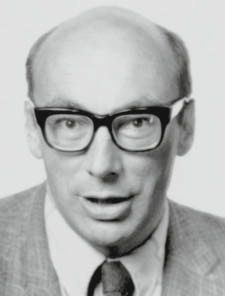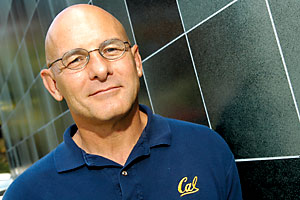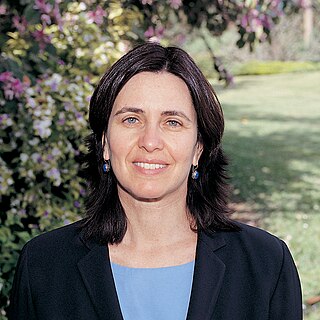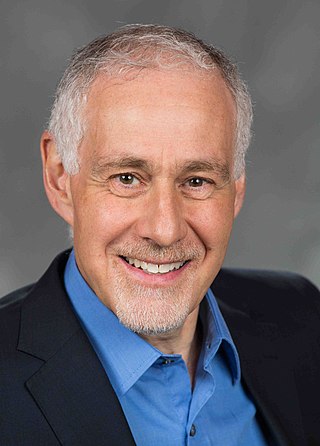Early life
Marvin Stein was born in Cleveland, Ohio in 1924 to Russian-Jewish immigrants. The family later moved to Los Angeles, California to treat Stein's mother's tuberculosis. [2] He graduated from Theodore Roosevelt High School in 1941, and immediately entered University of California, Los Angeles. [3] His studies were interrupted and in 1942 he served in the US Army Signal Corps as a tabulating machine operator, and had a short stint working at IBM. He returned to school after the war and graduated from UCLA in 1947. [4]
Stein did his Ph.D. at the Institute for Numerical Analysis at UCLA (or INA, an ancestor of UCLA's computer science department), where in the summer of 1949 he participated in a seminar on solving linear equations and finding eigenvalues and eigenvectors of matrices with several other future luminaries of the domain, including Magnus Hestenes, J. Barkley Rosser, George Forsythe, Cornelius Lanczos, Gertrude Blanch, and William Karush. Magnus Hestenes's work on the conjugate gradient method was a direct outgrowth of this group's work together over the summer. [5] High speed computers were not available yet, so numerical experiments to test theoretical results were performed by hand by Stein and other researchers. Stein in particular studied Rayleigh–Ritz methods of variational problems. [6]
After earning his Ph.D. from the INA in January 1951, Stein was hired as a senior research engineer by aircraft manufacturer Convair in southern California. He primarily worked on missile simulations for the SM-65 Atlas, [4] on which he worked with a UNIVAC 1103. Though the 1103 had been made for and used by the Armed Forces Security Agency under the name "Atlas 2", this was the first commercially sold 1103. Stein's work installing the UNIVAC 1103 with Minnesotan and University of Minnesota alumnus Erwin Tomash introduced him to the emerging computer-science scene in Minnesota in the 1950s. [7]
Stein lost his job with Convair when his security clearance was revoked by the House Un-American Activities Committee on account of Stein's Jewish heritage. It was later re-instated, but Stein had already decided to move on. [2]
University of Minnesota
In 1955, Remington Rand, manufacturer of the UNIVAC computers, heard that the University of Minnesota was considering purchasing a machine from one of Rand's rivals: an IBM 650. Rand offered to simply give the university 400 free hours on a UNIVAC 1103 on the condition that they hire a dedicated faculty member to oversee its operations. Stein was hired in the IT Mathematics department in the University of Minnesota to fulfill this condition, and he assumed stewardship of the UNIVAC. [8] The UNIVAC 1103 was around 60 feet long, 30 feet wide, and weighed over 17 tons. [1]
Stein taught the first University of Minnesota courses on high-speed computation and played a singular role in developing the university's path to computer science education. In 1958, Stein was made the head of the university's Numerical Analysis Center at the Institute of Technology (later the University Computer Center), for which the university purchased its own 1103 at a discounted price of $250,000. The center was also home to a REAC 100. [7] Stein maintained a computer archives system for decades, over three significantly different generations of machine. [9]
In 1967, Stein created - with William Munro, Neal Amundson, and Hans Weinberger - the university's graduate program in Computer and Information Sciences. Three years later, in 1970, the university established a formal Computer Science department. [7] Stein resigned as head of the Computer Center and became the first head of this new Computer Science department. [10] He stepped down the following year, and served as a professor in the department until his retirement in 1997. [1]
Stein received a Guggenheim fellowship in 1963-1964 for his work with Magnus Hestenes on the conjugate gradient method and for being the principal inventor of the Pope-Stein division algorithm and the Stein-Rose sorting algorithm. [1] He served as a visiting professor of computer science at Weizmann Institute of Science in Rehovot, Israel from 1963 to 1964 and at Tel Aviv University and Hebrew University of Jerusalem from 1971 to 1972. [2]
The Association for Computing Machinery (ACM) is a US-based international learned society for computing. It was founded in 1947 and is the world's largest scientific and educational computing society. The ACM is a non-profit professional membership group, claiming nearly 110,000 student and professional members as of 2022. Its headquarters are in New York City.
The ACM A. M. Turing Award is an annual prize given by the Association for Computing Machinery (ACM) for contributions of lasting and major technical importance to computer science. It is generally recognized as the highest distinction in computer science and is colloquially known as or often referred to as the "Nobel Prize of Computing".

Sir Charles Antony Richard Hoare is a British computer scientist who has made foundational contributions to programming languages, algorithms, operating systems, formal verification, and concurrent computing. His work earned him the Turing Award, usually regarded as the highest distinction in computer science, in 1980.

Leslie B. Lamport is an American computer scientist and mathematician. Lamport is best known for his seminal work in distributed systems, and as the initial developer of the document preparation system LaTeX and the author of its first manual.

Alan Jay Perlis was an American computer scientist and professor at Purdue University, Carnegie Mellon University and Yale University. He is best known for his pioneering work in programming languages and was the first recipient of the Turing Award.

Peter John Landin was a British computer scientist. He was one of the first to realise that the lambda calculus could be used to model a programming language, an insight that is essential to the development of both functional programming and denotational semantics.

David Andrew Patterson is an American computer pioneer and academic who has held the position of professor of computer science at the University of California, Berkeley since 1976. He announced retirement in 2016 after serving nearly forty years, becoming a distinguished software engineer at Google. He currently is vice chair of the board of directors of the RISC-V Foundation, and the Pardee Professor of Computer Science, Emeritus at UC Berkeley.

Shafrira Goldwasser is an Israeli-American computer scientist and winner of the Turing Award in 2012. She is the RSA Professor of Electrical Engineering and Computer Science at Massachusetts Institute of Technology; a professor of mathematical sciences at the Weizmann Institute of Science, Israel; the director of the Simons Institute for the Theory of Computing at the University of California, Berkeley; and co-founder and chief scientist of Duality Technologies.

Peter James Denning is an American computer scientist and writer. He is best known for pioneering work in virtual memory, especially for inventing the working-set model for program behavior, which addressed thrashing in operating systems and became the reference standard for all memory management policies. He is also known for his works on principles of operating systems, operational analysis of queueing network systems, design and implementation of CSNET, the ACM digital library, and codifying the great principles of computing. He has written numerous influential articles and books, including an overview of fundamental computer science principles, computational thinking, and his thoughts on innovation as a set of learnable practices.

Robert Stanley "Bob" Barton was the chief architect of the Burroughs B5000 and other computers such as the B1700, a co-inventor of dataflow architecture, and an influential professor at the University of Utah.

Barbara Liskov is an American computer scientist who has made pioneering contributions to programming languages and distributed computing. Her notable work includes the introduction of abstract data types and the accompanying principle of data abstraction, along with the Liskov substitution principle, which applies these ideas to object-oriented programming, subtyping, and inheritance. Her work was recognized with the 2008 Turing Award, the highest distinction in computer science.
Jean E. Sammet was an American computer scientist who developed the FORMAC programming language in 1962. She was also one of the developers of the influential COBOL programming language.

Bernard A. Galler was an American mathematician and computer scientist at the University of Michigan who was involved in the development of large-scale operating systems and computer languages including the MAD programming language and the Michigan Terminal System operating system.
Douglas Taylor "Doug" Ross was an American computer scientist pioneer, and chairman of SofTech, Inc. He is most famous for originating the term CAD for computer-aided design, and is considered to be the father of Automatically Programmed Tools (APT), a programming language to drive numerical control in manufacturing. His later work focused on a pseudophilosophy he developed and named Plex.

Mark Joseph Guzdial is a Professor in the College of Engineering at the University of Michigan. He was formerly a professor in the School of Interactive Computing at the Georgia Institute of Technology affiliated with the College of Computing and the GVU Center. He has conducted research in the fields of computer science education and the learning sciences and internationally in the field of Information Technology. From 2001–2003, he was selected to be an ACM Distinguished Lecturer, and in 2007 he was appointed Vice-Chair of the ACM Education Board Council. He was the original developer of the CoWeb, one of the earliest wiki engines, which was implemented in Squeak and has been in use at institutions of higher education since 1998. He is the inventor of the Media Computation approach to learning introductory computing, which uses contextualized computing education to attract and retain students.
Margaret Martonosi is an American computer scientist who is currently the Hugh Trumbull Adams '35 Professor of Computer Science at Princeton University. Martonosi is noted for her research in computer architecture and mobile computing with a particular focus on power-efficiency.

Alexander L. Wolf is a Computer Scientist known for his research in software engineering, distributed systems, and computer networking. He is credited, along with his many collaborators, with introducing the modern study of software architecture, content-based publish/subscribe messaging, content-based networking, automated process discovery, and the software deployment lifecycle. Wolf's 1985 Ph.D. dissertation developed language features for expressing a module's import/export specifications and the notion of multiple interfaces for a type, both of which are now common in modern computer programming languages.
Maria Gini is an Italian and American Computer Scientist in artificial intelligence and robotics. She has considerable service to the computer science artificial intelligence community and for broadening participation in computing. She was Chair of the ACM Special Interest Group in Artificial Intelligence SIGAI from 2003 to 2010. She is currently a member of the CRA-W board.
Marvin Victor Zelkowitz is an American computer scientist and engineer.











